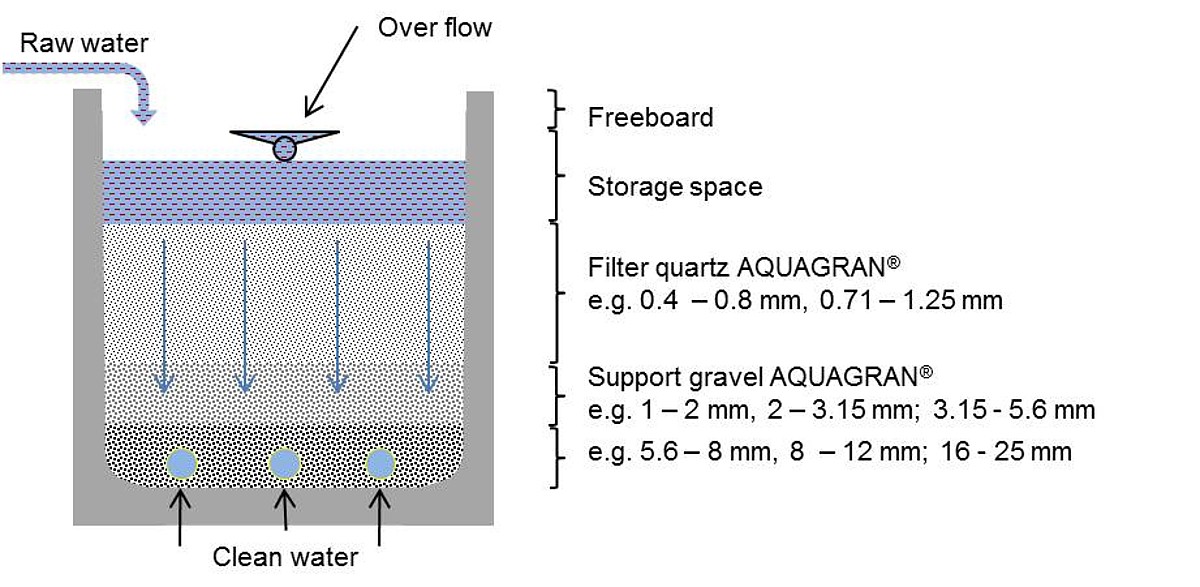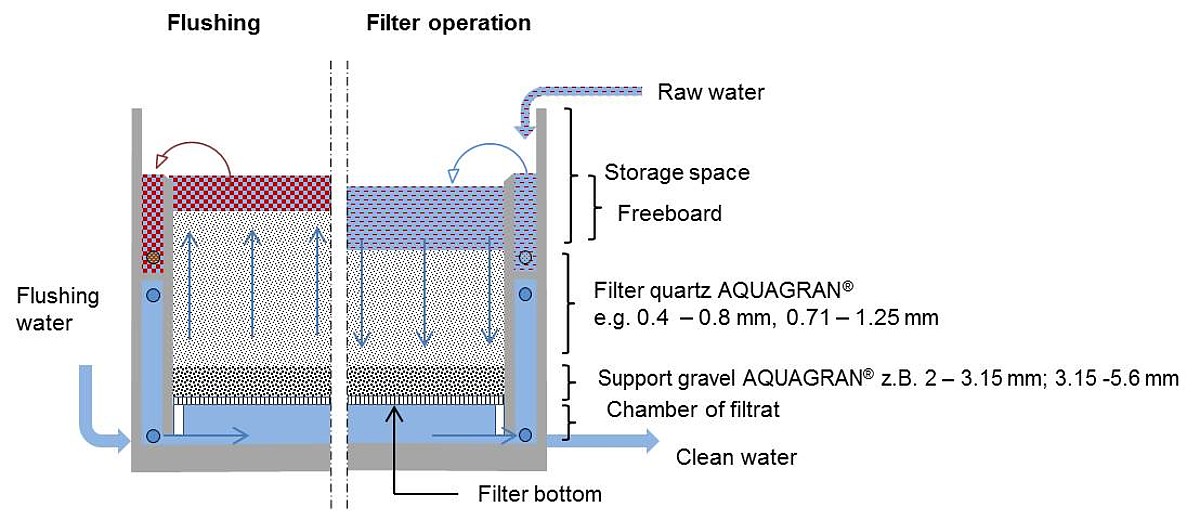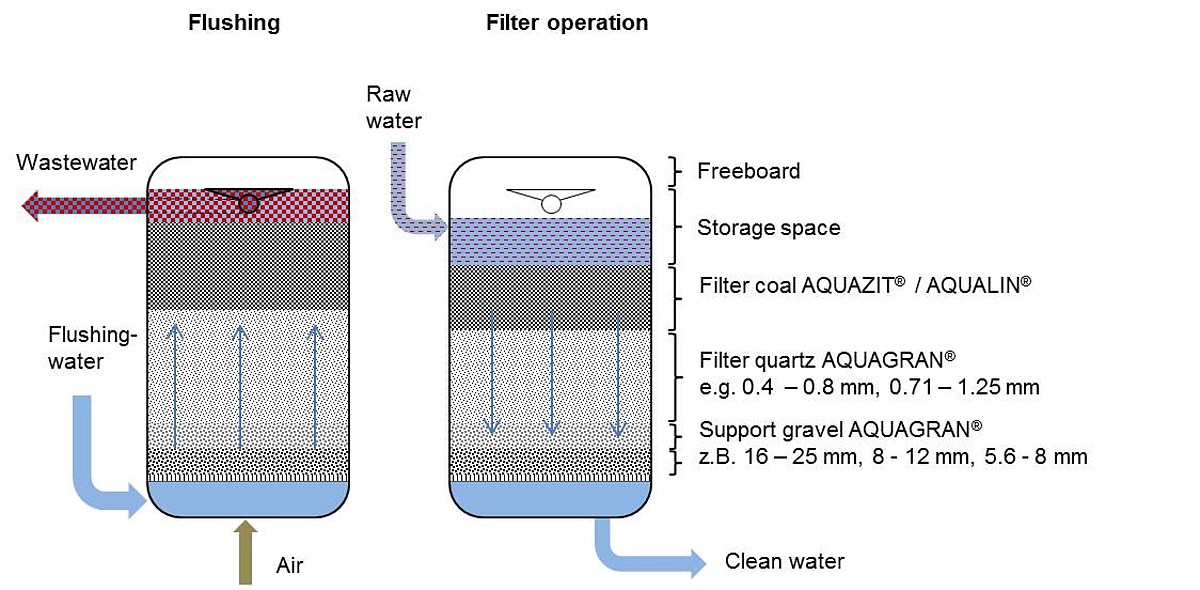Different methods
4. The different technical methods
The efficiency of the filter is determined primarily by:
- The properties of the dirt particles (which is the contamination and how big are the particles
- Type of filtration (Mono or, multi layer filter)
- Flow rate
- Type and quality of filter gravel
- Filter life respectively level of contermination
- High of the bed
- Type and quality of flushing
| - | Slow filter | Qick filter | |
|---|---|---|---|
| open | open | closed | |
Type / (Layout) | Earth pits Concrete basin | Concrete basin | Steel filter |
| Common Filter speed [m/h] | 0.05 - 0.3 | 4 - 7 | 10 - 20 |
Common Filer life (before back flushing or revision) [d] | 50 - 100 | 0.5 - 10 | 0.5 - 10 |
| Common Flushing speed [m/h] Water Air | - -
|
8 - 80 up to 60 |
8 - 80 up to 60 |
Tab. 1 Presentation of fundamentally different methods
4.1 Which method is chosen?
When selecting the method, the water quality and availability plays a major role. Is there enough flushing water in operation yet and where are the residues disposed? Also to be noted: temperature, turbidity, particle count, organics, etc.
However, other factors such as the expected water demand and its peaks or even the presence of possible sources of danger, are important factors. The available space plays just as important a role as the available budget.
Further you have to consider what will happen over the subsequent operation. Is there for example, always qualified staff on site and is the plant scheduled to run almost fully automatically? How many staff is oncall?
Which chemicals are needed, how can you prevent unauthorized access or mishandling?
4.2 Open slow filtration
By definition, slow filters are filters in which the filter medium is made of granular materials and through which waterflows a few meters per day.
Slow filters generally have a very large area up to 10,000 m². The water to be filtered flows through the filter at a low speed of a few meters per day. Back flushing is not possible. It forms a layer of residues on the surface of the filter medium. This layer is also referred as biofilm or bacteria bed. Typically contained algae, fungi, solids and various microorganisms.
Increases the filter resistance to a critical level, the filter must be cleaned. The contaminated filter grain (usually filter sand) must be peeled and washed before it can be brought back to the filter surface (usually filter sand). The filter material has to be washed in another place. The filtrate is collected in drainage pipes, which often have a large diameter of up to 1 m. A particular problem of this technique is to keep the drains free of silt or other fine fractions.
Slow filters act in different ways. Find next to the filter effect, during the passage through the filter. a number of biological (degradation of organic products) and chemical (hydrolysis, oxidation) processes take place. The filter must run longer (it have to come in process) in order to be fully effective. In addition to the removal of turbidity further aims are e.g. to reduce the number of bacteria, the elimination of pathogens, the mineralization of org. materials just to name a few.
Open slowly filters are often used in the treatment of industrial waters, or as a precursor for drinking water treatment.
4.2 Quick filtration
By definition, quick filters are filter in which the filter medium is made of granular materials and through which water flows a several meters per day.
There are basically two different types of quick filters. Open quick filters to realize filters speeds up to 15 m/h and closed (pressure) quick filters provide up to 30 m/h.
Quick filters are often used in combination with other - downstream processes - such as flocculation. Quick filters are i.a. characterized by the permeable floor on which the filter material is installed. The permeable soil located above the pure water chamber. There are two types of such filter floors - with and without special nozzles. In both cases serve slots in the bottom to let the water in the filter operation run down and to direct the water or air flow in the backwash upwards.
Fast filters are generally built as a multi-layer filter. Directly on the permeable soil is the support layer. This consists of coarse material and has to make the tasks that the filter bed is not in disorder and the flushing water and purge air are uniformly distributed over the entire filter surface. Above the support layer is the filter sand.
Above the filter sand is in many cases a filter carbon attached. The coordination of the individual grains to one another is extremely important. Firstly, the individual layers are mixed as little as possible, on the other hand must at the same lift by backwashing the filter material each overhead more fluidize (see Fig. 3.3).

Dipl.-Ing.
Holger Vespermannsales manager, proxy holder
| +49 02362 - 2005-30 | |
| +49 02362 - 2005-99 | |
| send |



